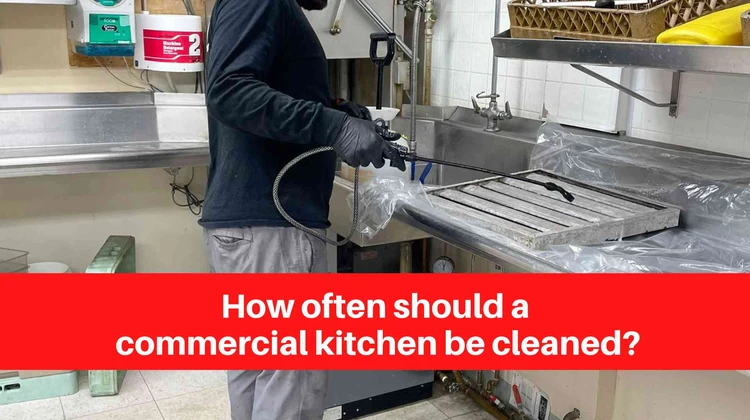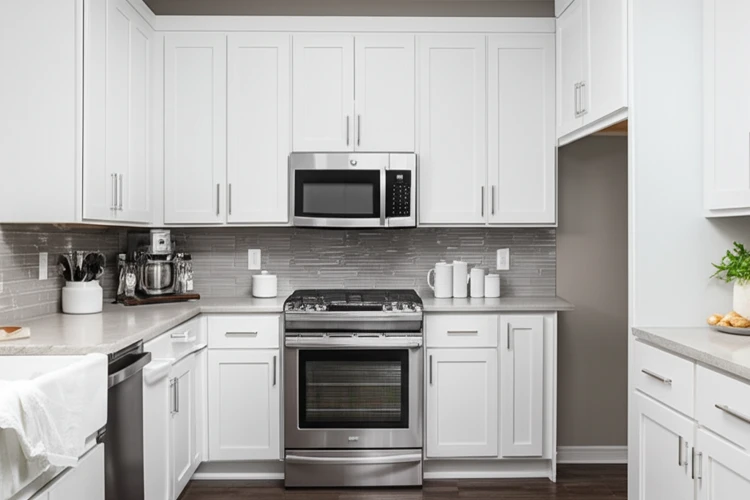Disclaimer: As an Amazon Associate, I earn commission from qualifying purchases.
Waking up to the faint aroma of last night’s pan-fried dinner, even hours later, can be a familiar experience. That subtle scent, however, is more than just a reminder of a tasty meal; it’s a sign that grease particles have permeated your kitchen. A “grease smell” in the kitchen isn’t just a simple odor; it’s a complex mix of airborne grease particles, volatilized cooking oils, and the breakdown products of fats and oils that have settled on surfaces.
This is a common problem, affecting homes across various cooking styles and frequencies. The lingering smell represents a build-up of unseen grease, which contributes to a less hygienic environment. Removing grease smell in kitchen is essential for several reasons. It enhances hygiene by eliminating potential breeding grounds for bacteria and other microorganisms.
It also contributes to a more pleasant living environment, improving your overall comfort. Moreover, a clean, odor-free kitchen can positively impact your property value, making it more appealing to potential buyers.
Identifying the Culprits: Pinpointing the Source of the Grease Smell
To effectively remove the grease smell, it’s crucial to identify where the smell is originating from. Grease doesn’t just float around; it settles, accumulates, and degrades, creating the unwelcome odor. Pinpointing the source is the first step in effective remediation.
- Range Hoods: This is one of the primary culprits. During cooking, range hoods draw in grease-laden air. Over time, grease accumulates on the filters, interior surfaces, and exterior of the hood. The warm, humid environment inside the hood can accelerate the breakdown of grease, leading to strong odors.
Grease migrates by being drawn into the hood’s ventilation system, where it condenses on the filters and other surfaces.
- Stovetops: The stovetop itself, especially around burners, is a major site of grease accumulation. Splattering from cooking oils and fats leaves a residue that, if not cleaned regularly, becomes rancid and odorous.
- Ovens: Ovens, especially self-cleaning ones, can trap grease, creating strong odors when used. Even with regular cleaning, small amounts of grease can remain and bake onto the oven surfaces.
- Microwaves: Splatters from heating food, particularly fatty foods, adhere to the interior walls and ceiling of the microwave. These residues can lead to a persistent, unpleasant smell.
- Floors: Grease can splatter onto floors during cooking, and it can seep into grout lines and other porous materials, creating difficult-to-remove odors.
Grease particles settle on flooring surfaces due to their proximity to the cooking area and air currents.
- Cabinets: Grease can travel through the air and settle on cabinet surfaces near the stovetop.
- Dishwashers: While designed for cleaning, dishwashers can accumulate grease residue, especially in the filter and drain areas, leading to a musty smell.
- Trash Cans: Kitchen trash cans, especially those that receive food waste, can be a source of lingering odors that combine with grease smells.
- Ventilation Systems: The ductwork of your range hood and other ventilation systems can accumulate grease over time, spreading odors throughout the kitchen, even after surface cleaning.

Appliance manufacturers provide guides for cleaning best practices. For instance, GE Appliances provides detailed cleaning instructions for their range hoods and ovens, emphasizing the importance of regular maintenance. Knowing where the grease settles is critical for targeted and effective cleaning.
Immediate Action: Quick Fixes for a Lingering Grease Smell
While a deep clean is ultimately necessary, some immediate actions can provide temporary relief from a lingering grease smell.
- Ventilation: Open windows and doors to allow fresh air to circulate. Use fans, including exhaust fans, to draw out the stale air and dilute the grease smell.
This works by removing the odorous air and replacing it with fresh air.
- Boiling Solutions: Boil water with vinegar, lemon slices, or cinnamon sticks on the stovetop. The steam carries the odor-absorbing or neutralizing agents throughout the kitchen, helping to combat the smell.
Vinegar’s acetic acid absorbs odors, while lemon and spices can provide a pleasant scent.
- Air Fresheners: Air fresheners can provide temporary masking of the grease smell. However, avoid relying solely on air fresheners, as they don’t address the root cause of the odor.
Air fresheners often use volatile organic compounds (VOCs) to mask odors but do not eliminate the grease.
These quick fixes are based on the science of odor neutralization. For instance, vinegar’s acetic acid is effective at absorbing and neutralizing odors. Air circulation works by diluting the concentration of odor molecules in the air, making the smell less noticeable. It is important to remember that these are temporary solutions and not a replacement for deep cleaning, which targets the grease itself.
The Deep Clean: Essential Cleaning Supplies and Tools
A thorough cleaning requires the right supplies and tools. Having the right cleaning agents is essential for effectively breaking down and removing grease.
- Degreaser: Choose a high-quality degreaser formulated for kitchen use.
- All-Purpose Cleaner: Useful for cleaning surfaces that are not heavily greased.
- Baking Soda: Excellent for absorbing odors and gentle scrubbing.
- Vinegar: A natural cleaning agent that cuts through grease and neutralizes odors.
- Microfiber Cloths: Effective for cleaning surfaces without scratching.
- Scrub Brushes: For tackling stubborn grease buildup.
- Disposable Gloves: Protect your hands from harsh cleaning chemicals.
Different types of degreasers include:
- Commercial Degreasers: Powerful formulas designed to cut through grease. They are usually effective but may contain harsh chemicals.
Commercial degreasers often contain surfactants and solvents that break down grease.
- DIY Degreasers: Made from household ingredients such as vinegar and baking soda. They are less harsh but may require more effort.
Here are some product recommendations. Consider your budget, the severity of grease buildup, and your preference for natural or chemical cleaners.
- Best Commercial Degreaser: Dawn Ultra Dish Soap (highly effective, readily available)
- Best Natural Degreaser: Vinegar and Baking Soda (effective, safe, economical)
- Best Scrub Brush: OXO Good Grips Deep Clean Brush Set (versatile, durable)
When choosing a degreaser, consider factors such as effectiveness, safety, and environmental impact. The Environmental Working Group (EWG) provides ratings of cleaning products based on their ingredients and potential health effects.
The Stovetop Showdown: Cleaning Your Cooktop and Range Hood
The stovetop and range hood are the main sources of grease and require focused cleaning.
- Stovetop Cleaning:
- Gas Stovetops: Remove grates and burner caps. Soak them in hot, soapy water or a degreaser solution. Wipe down the stovetop surface. Use a degreaser to remove stubborn grease. Rinse all parts thoroughly and dry completely before reassembling.
- Electric Stovetops: For smooth-top electric stoves, wipe down the surface with a degreaser or a specialized cleaner. For coil-top electric stoves, remove the coils and clean the drip pans with a degreaser.
- Range Hood Cleaning: This is a crucial step in eliminating kitchen grease smells.
- Safety First: Unplug the range hood or turn off the circuit breaker. Remove the filters.
- Filter Cleaning: Soak the filters in hot, soapy water or a degreaser solution. Scrub gently with a brush to remove grease. Rinse thoroughly and let dry completely. Some filters are dishwasher-safe; check your manufacturer’s instructions.
Range hood filters trap grease particles as they rise.
- Exterior Cleaning: Wipe down the exterior of the range hood with a degreaser or all-purpose cleaner.
- Interior Cleaning: Carefully clean the interior of the range hood, including the fan blades, with a degreaser. This part is often overlooked but can harbor significant grease buildup.
Always prioritize safety when cleaning appliances. Appliance manufacturers, like Whirlpool and KitchenAid, often provide detailed instructions for cleaning their products. Always unplug appliances and use appropriate protective gear, like gloves and eye protection. Improper cleaning techniques, such as using abrasive cleaners on delicate surfaces, can damage your appliances.
Oven Overhaul: Removing Baked-On Grease and Odors
Cleaning your oven effectively eliminates odors and grease, it is a key component of any kitchen odor removal strategy.
- Self-Cleaning Oven:
- Remove oven racks and any other removable parts.
- Follow the manufacturer’s instructions for the self-cleaning cycle. Ensure proper ventilation during the cycle.
- After the cycle is complete, let the oven cool completely. Wipe down the interior to remove any ash.
- Manual Cleaning (for ovens without a self-cleaning function):
- Remove oven racks and soak them in hot, soapy water or a degreaser.
- Use a degreaser or a paste of baking soda and water to clean the oven interior. Allow it to sit for several hours or overnight.
- Scrub the interior, paying attention to areas with baked-on grease.
- Rinse thoroughly with water and dry completely.
- Removing Stubborn Baked-On Grease:
- Use a commercial oven cleaner according to the product instructions.
- Try a paste of baking soda and water: Apply it to the greasy areas, let it sit, and scrub.
- Use a scraper or a razor blade (carefully) to remove hardened grease.
- Eliminating Oven Odors:
- Bake a mixture of baking soda and water in the oven at a low temperature.
- Place a bowl of lemon juice in the oven and heat it to a low temperature.
- Troubleshooting:
- Oven Smoke: If your oven smokes during self-cleaning or manual cleaning, it may be due to excessive grease buildup. Open windows and increase ventilation.
Always refer to your oven’s manual for specific cleaning instructions and safety guidelines. Failure to follow these guidelines can cause damage to the oven or create a fire hazard. For instance, never use harsh chemicals on self-cleaning ovens.
Addressing the Other Culprits: Microwaves, Dishwashers, and More
Other kitchen appliances and surfaces also contribute to grease accumulation and odor.
- Microwave Cleaning:
- Place a bowl of water with lemon slices or vinegar in the microwave. Heat it for a few minutes until the water boils and steam forms.
- Let it sit for a few minutes to loosen splatters.
- Wipe down the interior with a damp cloth or sponge.
- Dishwasher Cleaning:
- Remove and clean the filter regularly to prevent odors.
- Run an empty cycle with a dishwasher cleaner or vinegar to remove grease and buildup.
- Cleaning Other Surfaces:
- Floors: Mop floors with a degreaser or a solution of vinegar and water.
- Cabinets: Wipe down cabinet surfaces with a degreaser or all-purpose cleaner.
- Countertops: Clean countertops with a degreaser or a surface cleaner.
- Removing Grease Stains from Walls and Backsplashes:
- Use a degreaser or a solution of baking soda and water.
- Test the cleaning solution in an inconspicuous area first.
- Wipe down the affected area with a clean cloth.
Cleaning appliances regularly, following manufacturer’s recommendations, is crucial. For example, dishwashers should have their filters cleaned at least once a month, and microwaves should be cleaned regularly to prevent grease buildup.
Ventilation Vanguards: Ensuring Proper Airflow and Extraction
Proper ventilation is critical for removing grease particles and odors from your kitchen.
- Importance of Proper Ventilation: Ventilation systems remove grease-laden air and replace it with fresh air. Proper ventilation is essential to ensure that odors and grease particles are extracted before they can settle on surfaces.
- Types of Ventilation Systems:
- Range Hoods: These are the most effective ventilation systems, capturing grease directly from the cooking surface.
- Exhaust Fans: These are often found in kitchens without range hoods and help to ventilate the air.
- Window Fans: Can provide additional ventilation, especially when combined with other systems.
- Maximizing Ventilation Efficiency:
- Clean or replace range hood filters regularly.
- Ensure that your ventilation system is properly installed and functioning.
- Open windows and use fans to increase airflow.
Proper ventilation is often dictated by building codes and industry standards. The International Residential Code (IRC) provides guidance on ventilation requirements for kitchens. Regularly cleaning and maintaining your ventilation system is an important step to keep your kitchen air fresh and clean.
Preventing Future Fouls: Maintenance and Proactive Strategies
Preventing grease smell is more than just cleaning; it involves consistent maintenance and proactive strategies.
- Develop a Cleaning Schedule: Create a regular cleaning schedule to prevent grease buildup. This includes wiping down surfaces after each cooking session and conducting a deep clean at least once a month.
This schedule should be based on your cooking frequency.
- Cooking Habits:
- Use lids when cooking to minimize splattering.
- Use low-fat cooking methods, such as baking and grilling.
- Wipe up spills immediately.
- Regular Filter Maintenance: Clean or replace range hood filters regularly. This is a critical preventive measure.
Filters trap grease and can become saturated, reducing their effectiveness.
Expert advice indicates that regular cleaning, combined with modifications to cooking habits, significantly reduces grease accumulation. This preventative approach is essential for a fresh kitchen environment. By following a consistent cleaning schedule, you can prevent grease from accumulating and developing unpleasant odors.
FAQs About How to Remove Grease Smell From Kitchen
Here are some frequently asked questions about removing grease smell from the kitchen:
How often should I clean my kitchen to prevent grease smell?
To prevent grease smell, aim for daily wipe-downs of stovetops and frequently used surfaces. A more thorough cleaning of the range hood, oven, and other appliances should be done at least once a month, or more frequently if you cook often. Maintaining a consistent cleaning schedule is essential.
Can I use baking soda to get rid of grease smell?
Yes, baking soda is an excellent natural deodorizer and cleaner that can help to remove grease smell. You can sprinkle baking soda on surfaces, let it sit, and then wipe it away. Baking soda can also be used in a paste with water for scrubbing. Placing an open box of baking soda in your kitchen can also help absorb odors.
What’s the best way to clean a range hood filter?
The best way to clean a range hood filter is to remove it and soak it in hot, soapy water or a degreaser solution. Allow the filter to soak for about 30 minutes. Scrub the filter gently with a brush to remove grease and residue. Rinse thoroughly and let it dry completely before returning it to your range hood.
How long does it take to remove a grease smell?
The time it takes to remove a grease smell depends on the severity of the odor and the methods used. Quick fixes, like ventilation and boiling solutions, can provide immediate relief. However, a deep clean, including cleaning all affected surfaces and appliances, is needed for long-lasting results. Depending on the size of your kitchen and the amount of cleaning needed, a complete removal may take a few hours to a day.
Are there any natural remedies for kitchen grease smell?
Yes, several natural remedies are effective for combating kitchen grease smell. These include using vinegar, lemon, baking soda, and essential oils like citrus or tea tree. Boiling water with vinegar or lemon slices is a great way to neutralize odors, and baking soda can be used for cleaning and odor absorption. For example, to eliminate oven odors you can use baking soda and lemon juice paste.
Conclusion
Dealing with kitchen grease smells can be a frustrating experience, but with the right knowledge and tools, a fresh, clean kitchen is well within your reach. This guide has provided a comprehensive approach, from identifying the source to implementing effective cleaning strategies. Regular cleaning and maintenance are key.
The steps involved in cleaning the range hood, stovetop, oven, and other surfaces can seem daunting at first, but the results—a fresh, odor-free kitchen—are well worth the effort. Regular cleaning helps to maintain a more hygienic and pleasant living space. By adopting a consistent cleaning routine and incorporating these tips into your kitchen maintenance, you can create a fresher, cleaner, and more welcoming environment. If you have your own tips or questions about removing grease smell, please share them in the comments below







